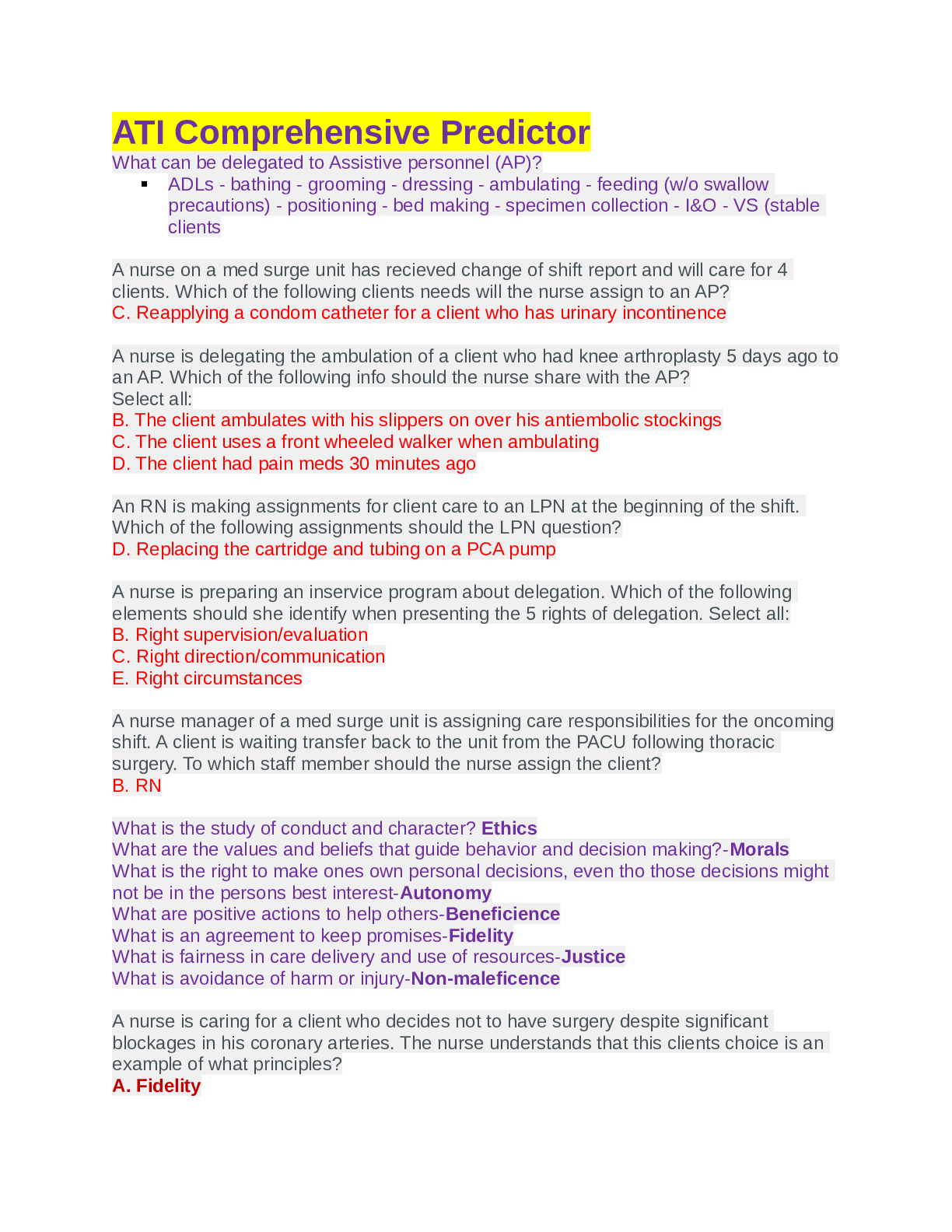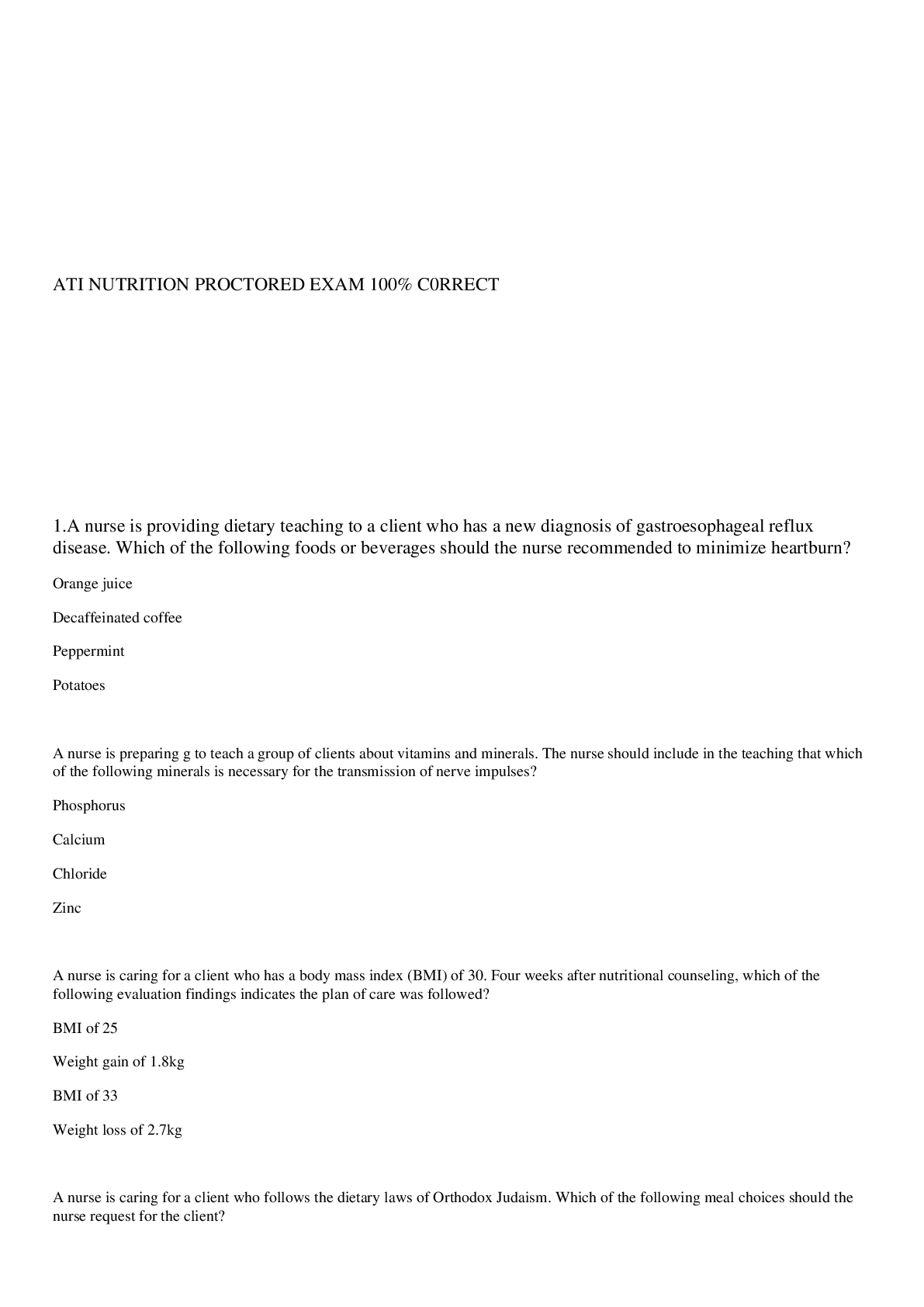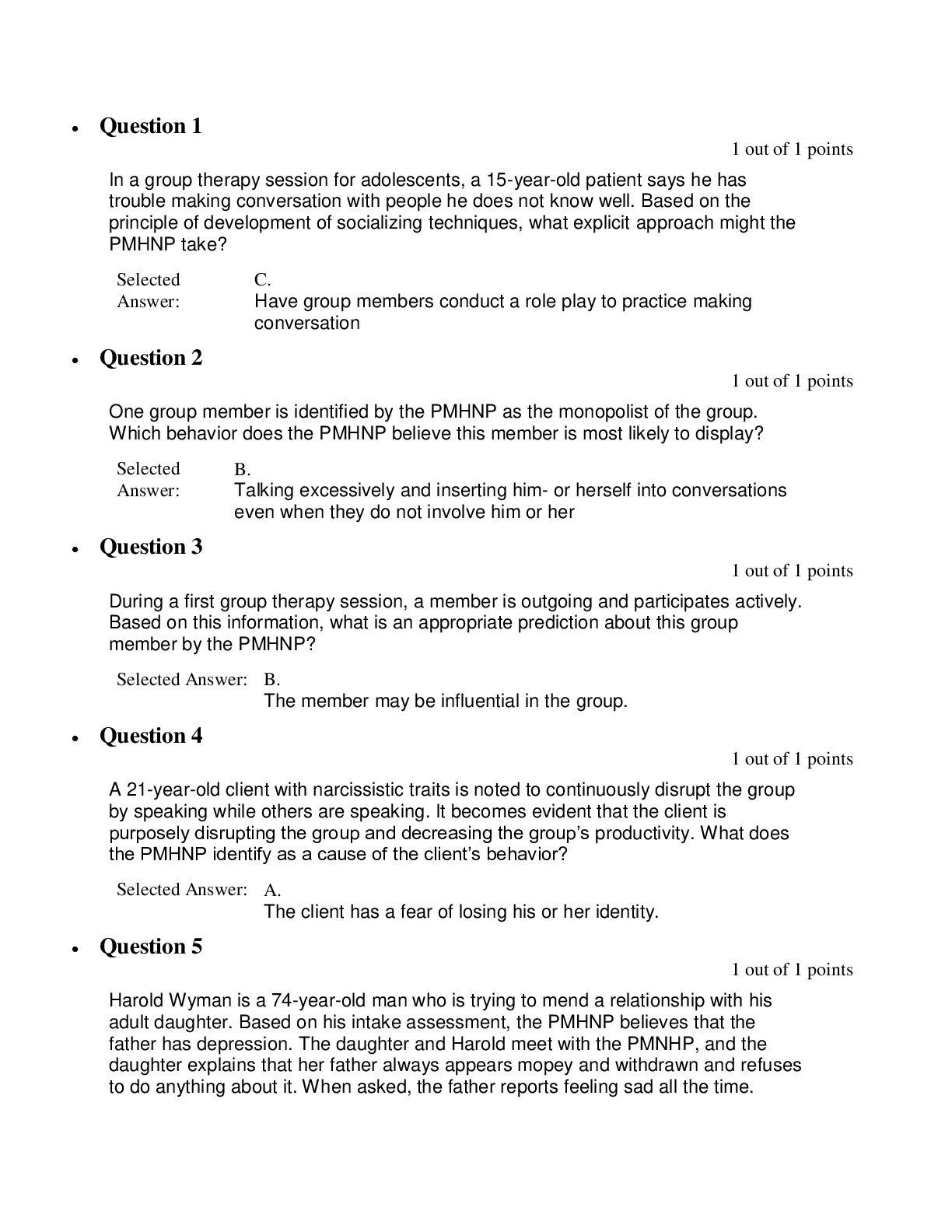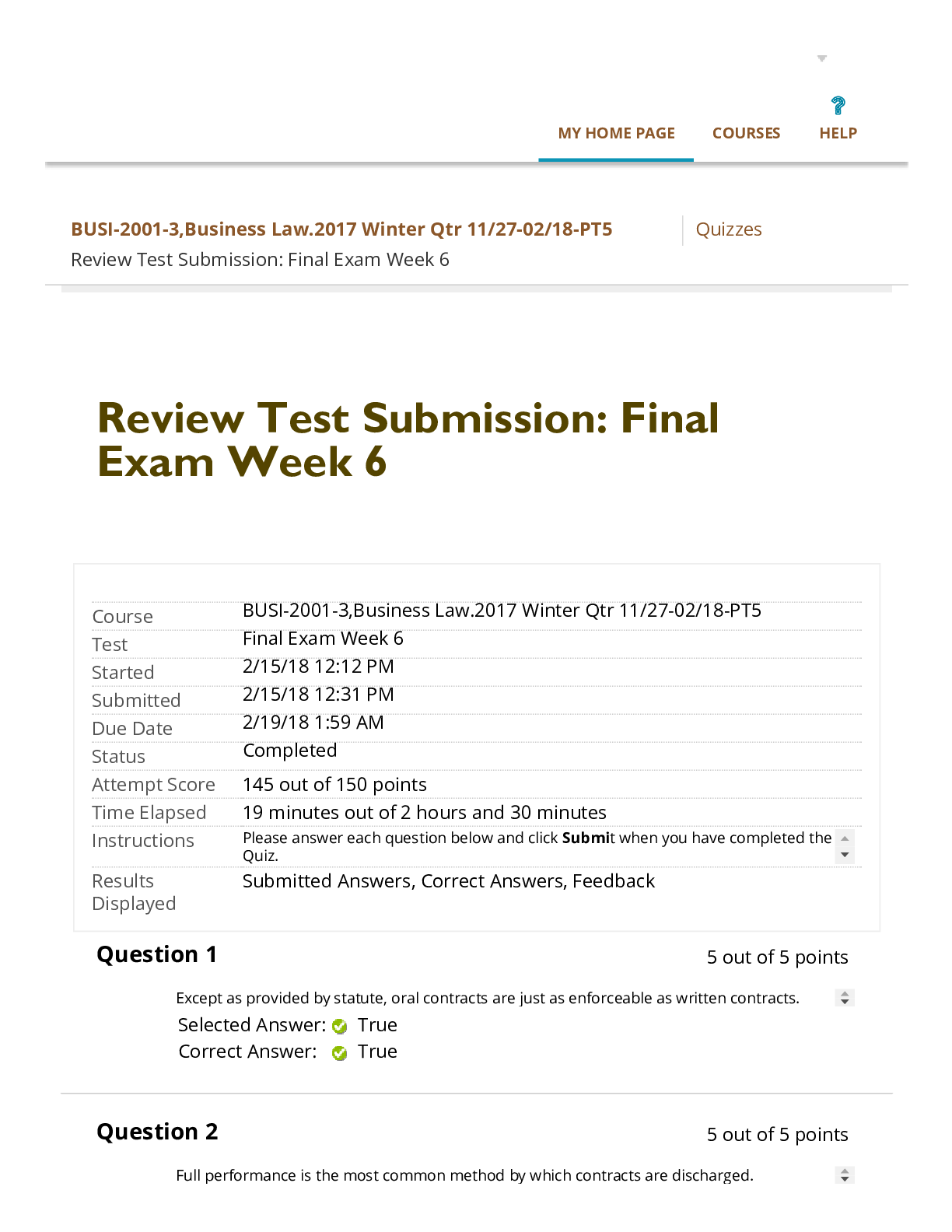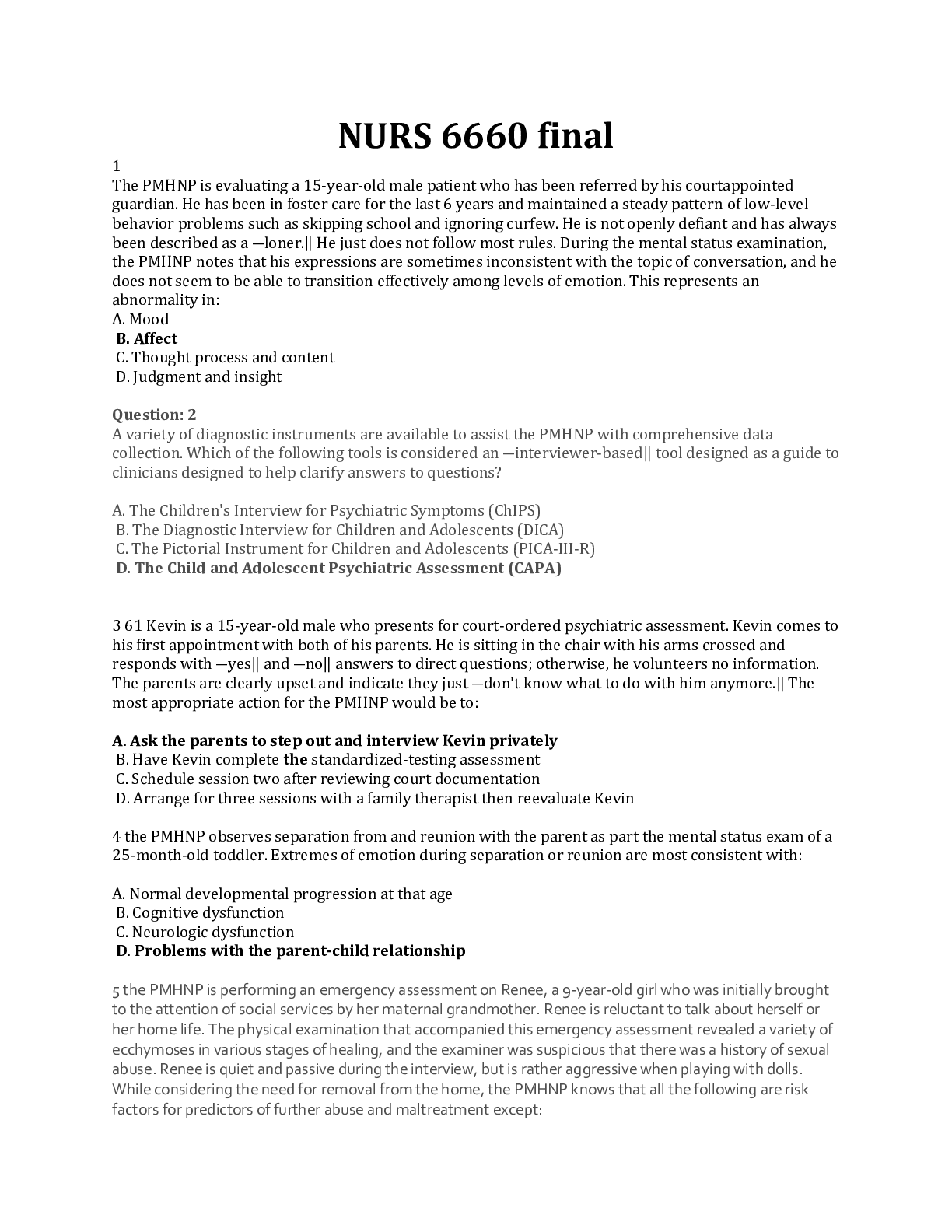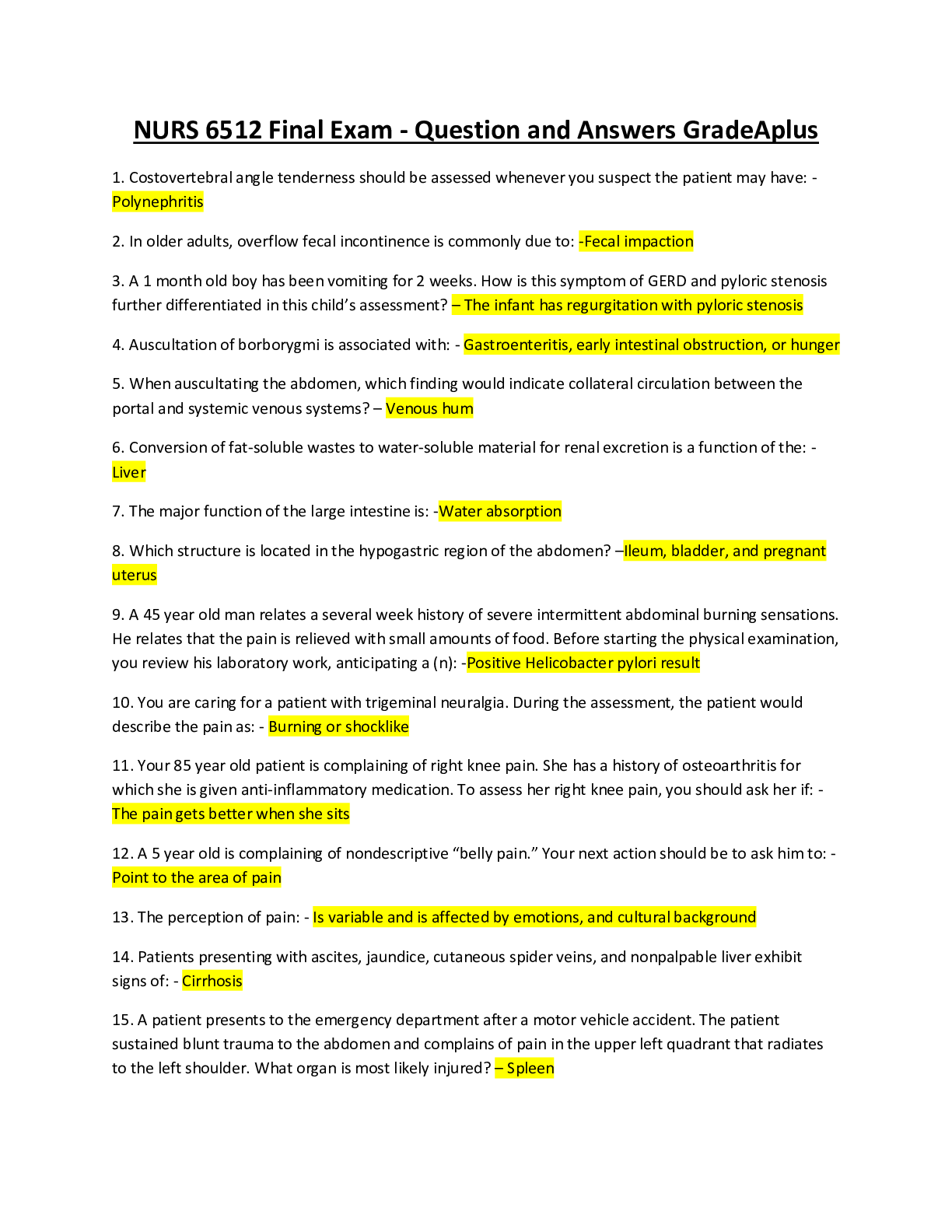BIOL 181 Final Exam - Spring 2019 (questions and answers)
Document Content and Description Below
University of Maryland, University College - BIOL 181 BIOL 181 Final Exam Each multiple-choice question is worth 2 points. Please pick the best answer to the following 50 questions. Attach only the an... swer sheet (provided) in your LEO assignments for grading. 1. The most diverse and inclusive classification group is the: a. domain b. genus c. kingdom d. phylum e. species 2. Which of the following scientific names are written correctly? a. Dermochelys coriacea b. Dermochelys coriacea c. Dermochelys coriacea d. Dermochelys coriacea e. none of the choices 3. Which of the following scientists defined a species as one or more groups of individuals that can potentially interbreed, produce fertile offspring, and do not interbreed with other groups? a. Charles Darwin b. Carolus Linnaeus c. Mary Leakey d. Gregor Mendel e. Ernst Mayr 4. The eighteenth-century naturalist Carolus Linnaeus is known for creating: a. the theory of natural selection b. a system for naming and classifying organisms c. the biological species concept d. the first microscope e. the scientific method 5. All of the following will strengthen a scientific theory except: a. repetitions of experiments b. increased number of observations c. time d. faith e. confirmation by many scientists 6. Critical thinking is the process of: a. finding fault in others b. unconditionally accepting information from a trusted source c. designing a scientific experiment d. making a hypothesis e. judging the quality of information before accepting it. 7. What is the major gas released into the environment when organic material is burned? a. O₂ b. CO₂ c. N₂ d. H₂ e. O₂ and H₂ 8. The idea that fossils were the remnants of ancient forms of life was developed because: a. fossils were found throughout the world. b. unique fossils are found in specific layers of stratified rocks. c. fossils resembled living organisms. d. fossils could be used to study past geologic events. e. all of these. 9. The large land mass that contained all the continents during the Triassic was called: a. Laurasia b. Pangea c. Gondwana d. Atlantis e. All of these 10. A species is composed of a. related organisms. b. a group of reproductive females. c. populations that have the potential to interbreed and produce fertile offspring. d. organisms located in the same habitat. e. all males and females in the same geographical range with the same ecological requirements. 11. The earliest species known to reproduce sexually was a a. archaebacterium. b. cyanobacterium. c. fungus. d. green alga. e. red alga. 12. The vast majority of animals are a. mammals. b. invertebrates. c. vertebrates. d. birds. e. predators. 13. The most successful of the invertebrate groups with respect to the numbers of species is a. Annelida. b. Arthropoda. c. Mollusca. d. Echinodermata. e. Nematoda. 14. Most animals show ________symmetry. a. bilateral b. multilateral c. no d. radial e. unilateral 15. A major explosion of animal diversity in which all major lineages were formed took place in the a. Cambrian b. Carboniferous c. Devonian d. Permian e. Proterozoic 16. Sponges are a. herbivores. b. filter feeders. c. scavengers. d. predators. e. carnivores. 17. Unlike other animals, sponges lack a. a digestive tract. b. a symmetrical body plan. c. tissues. d. a digestive tract and a symmetrical body plan. e. a digestive tract, a symmetrical body plan, and tissues. 18. Nematocysts are found only in a. cnidarians. b. nematodes. c. crustaceans. d. echinoderms. e. flatworms. 19. The term ‘coral bleaching’ refers to a. the change in color of coral reefs due to global warming. b. the loss of photosynthetic dinoflagellates, causing reef-building corals to die. c. the color change in coral reefs as they become mature. d. an invasion of a coral reef by colorless protists as opposed to green, photosynthetic ones. e. none of these answers. 20. A mantle is found only among the a. arthropods. b. annelids. c. echinoderms. d. mollusks. e. chordates. 21. A radula is which of the following? a. foot b. feeding organ c. ear d. sensitive hair e. balance organ 22. Cephalopods are the only mollusk that possess a. a mantle. b. gills. c. a foot modified into tentacles. d. “jet” propulsion e. a foot modified into tentacles and “jet” propulsion. 23. The mollusks with the largest brain and most complex behavior are the a. chitons b. cephalopods. c. gastropods. d. bivalves (clams). e. chelicerates. 24. What is the most diverse group within the mollusks? a. chitons b. cephalopods c. gastropods d. bivalves e. cnidarians 25. Sea slugs may protect themselves by using which of the following methods? a. the raspy radula may be used as a defense organ to injure potential predators. b. They make and secrete distasteful substances. c. They use camouflage. d. They only store unused nematocysts from cnidarians they have eaten. e. They make and secrete distasteful substances and store unused nematocysts from cnidarians they have eaten. 26. Molting in arthropods involves primarily a change in a. sex. b. body size. c. eating habits. d. sensory structures. e. none of these. 27. Arthropods usually detect odors with their a. antennae. b. legs. c. mouths. d. noses. e. eyes. 28. Which of the following is not an adaptation that contributed to arthropod success? a. modified segments b. jointed appendages c. closed circulatory system d. sensory specialization e. specialized developmental stages 29. Which is not a chelicerate? a. tick b. mosquito c. spider d. scorpion e. horseshoe crab 30. Which of the following is not a crustacean? a. horseshoe crab b. barnacle c. lobster d. shrimp e. decapods 31. Which of the following are features of the echinoderms? a. spiny skin b. decentralized nervous system c. radial symmetry d. a water-vascular system e. all of these answers are correct 32. Four of the five mollusks listed below possess an open circulatory system. Select the exception. a. clam b. chiton c. squid d. slug e. snail 33. Four of the five answers listed below are members of a common group. Select the exception. a. sea star b. sea anemone c. sea urchin d. sand dollar e. sea cucumber 34. Whales are still shrouded in mystery, yet the little we do know about them is both astonishing and awe-inspiring. The blue whale is the largest animal on Earth. Which whale can dive the deepest? a) Humpback whales b) Sperm whales c) Killer whales d) Belugas e) Killer Whales 35. Which of the following statements most accurately describes the importance of the first Archaeopteryx fossil? a. This fossil was discovered just in time for Darwin’s publication On the Origin of Species, and so provided credibility to his work. b. The location of this discovery was a key to documenting the link between lineages of vertebrates located at the discovery site, in China. c. The fossil demonstrated features of both birds and reptiles, providing a link between these possibly related lineages. d. The fossil Sinosauropteryx was actually a more important discovery than the first Archaeopteryx. e. None of these answers are correct. 36. Which of the following habitats is most likely to be rich in fossils? a. eroding hillsides b. deserts c. polar ice caps d. bed of former shallow sea e. rocky plateau 37. Plastic pollution has the potential to cause the following problems(s) for marine organisms: a) Marine mammals and birds are susceptible to being entangled in and strangled by larger pieces of plastic. b) Many filter-feeding organisms near the bottom of the ocean food chain constantly ingest the smaller degraded pieces of plastic. c) The degraded plastic pieces may absorb and transport hazardous chemicals such as PCBs into marine food webs when organisms ingest the plastic. d) Sea turtles might think floating plastic balloons are jellyfish. Ingesting balloons can make them very sick, even kill them. e) All of the above 38. Production of coal is a. something that occurred during the Carboniferous period. b. occurring on a continual basis in present time. c. something that occurred during the Ordovician period only. d. something that occurred during the Carboniferous period, and continues to occur today. e. none of these answers. 39. Which statement is not true? a. All chordates have notochords. b. All chordates have pharyngeal pouches or slits. c. All chordates have dorsal tubular nerve cords. d. All chordates are vertebrates. e. Chordates are found in all major types of environments. 40. The vertebrate fish group that most likely gave rise to the tetrapods are the a. ray-finned fishes. b. cartilaginous fishes. c. hagfishes. d. lampreys. e. lobe-finned fishes. 41. Which vertebrate adaptation allowed dispersal to land-based life that was completely independent of water? a. four-legged travel b. bony appendages c. hinged skeletal elements called jaws d. development of embryos within waterproof membranes e. bony appendages and four-legged travel are the most important features 42. The most primitive vertebrates are members of the group of a. jawless fishes. b. amphibians. c. cartilaginous fish. d. birds. e. bony fish. 43. The vertebrate jaw first appeared in which organism? a. fishes b. amphibians c. reptiles d. birds e. mammals 44. The feeding habits of lampreys are best described as a. suspension feeding. b. predatory. c. parasitic. d. scavenging. e. all of these 45. Sharks, rays, and skates belong to what group? a. birds b. amphibians c. bony fish d. reptiles e. cartilaginous fish 46. The diversity of the fishes exceeds that of all other vertebrate groups. Within the fishes, the most diverse group is the a. skates and rays. b. ray-finned fishes. c. lobe-finned fishes. d. hagfish and lampreys. e. it is a tie between the ray-finned and lobe-finned groups. 47. You have taken a summer job working as a field technician for a biological exploration in the Arctic. During the course of the summer, the expedition leaders become very excited about the discovery of a fish skeleton that shows bones extending out from the vertebral column that appear as small appendages. From your biology coursework, you realize that this fish could be classified as a a. lobe-finned fish. b. hagfish c. stingray. d. shark. e. ray-finned fish. 48. Which existing reptile group is most closely related to birds? a. lizards b. snakes c. crocodilians d. tuataras e. turtles 49. The descriptive term ectotherm, when applied to reptiles, refers to the fact that a. they are warm-blooded. b. they derive their body heat from outside of their body by certain behaviors. c. their central body core works best when its temperature is the same as the ambient temperatures. d. their optimum temperature for muscle contraction occurs only when the sun provides direct solar heat. e. none of these answers are correct. 50. Carbon is stored in what form? a. biomass b. fossil fuels c. limestone rocks d. shells of animals e. all of these [Show More]
Last updated: 1 year ago
Preview 1 out of 10 pages
Instant download
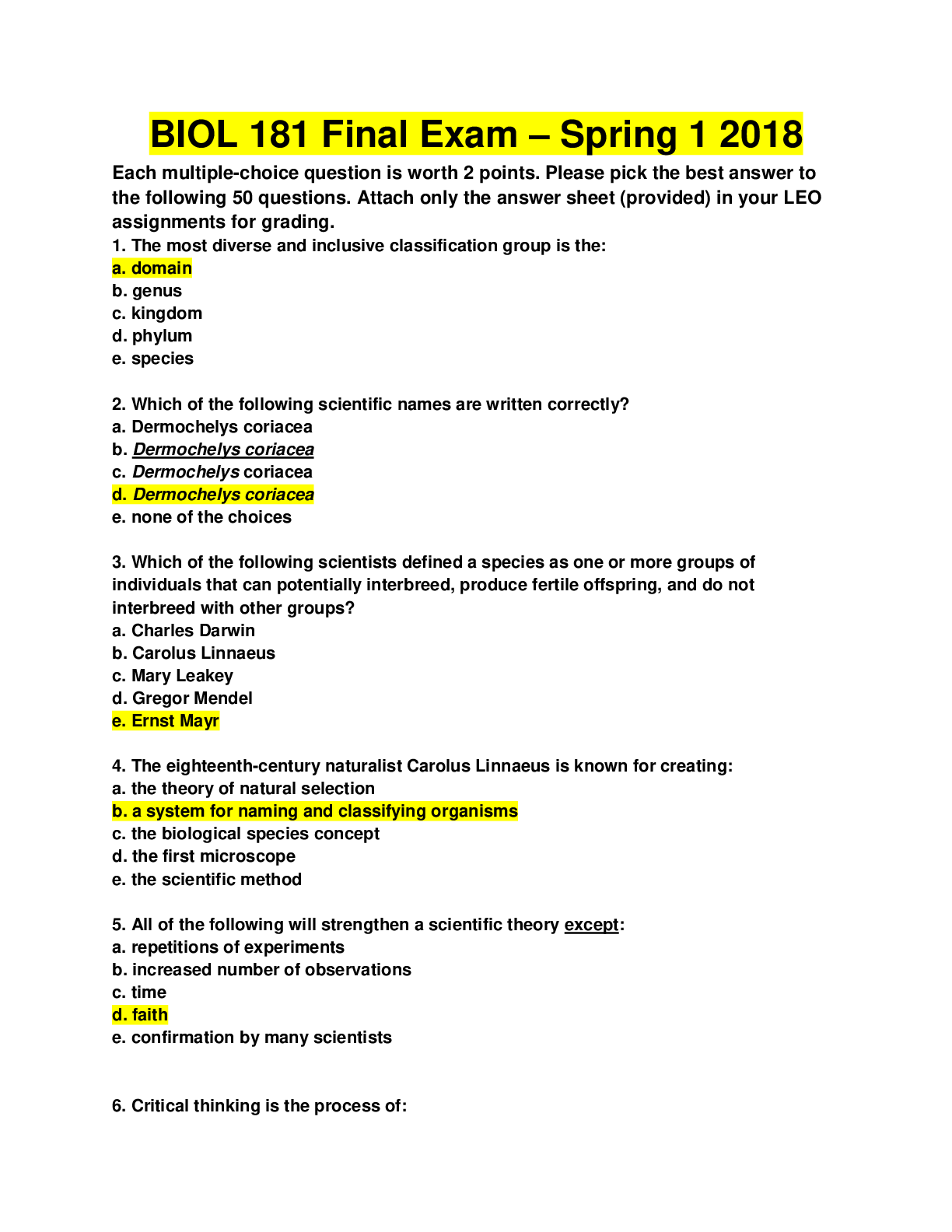
Buy this document to get the full access instantly
Instant Download Access after purchase
Add to cartInstant download
Reviews( 0 )
Document information
Connected school, study & course
About the document
Uploaded On
Jan 19, 2021
Number of pages
10
Written in
Additional information
This document has been written for:
Uploaded
Jan 19, 2021
Downloads
0
Views
43



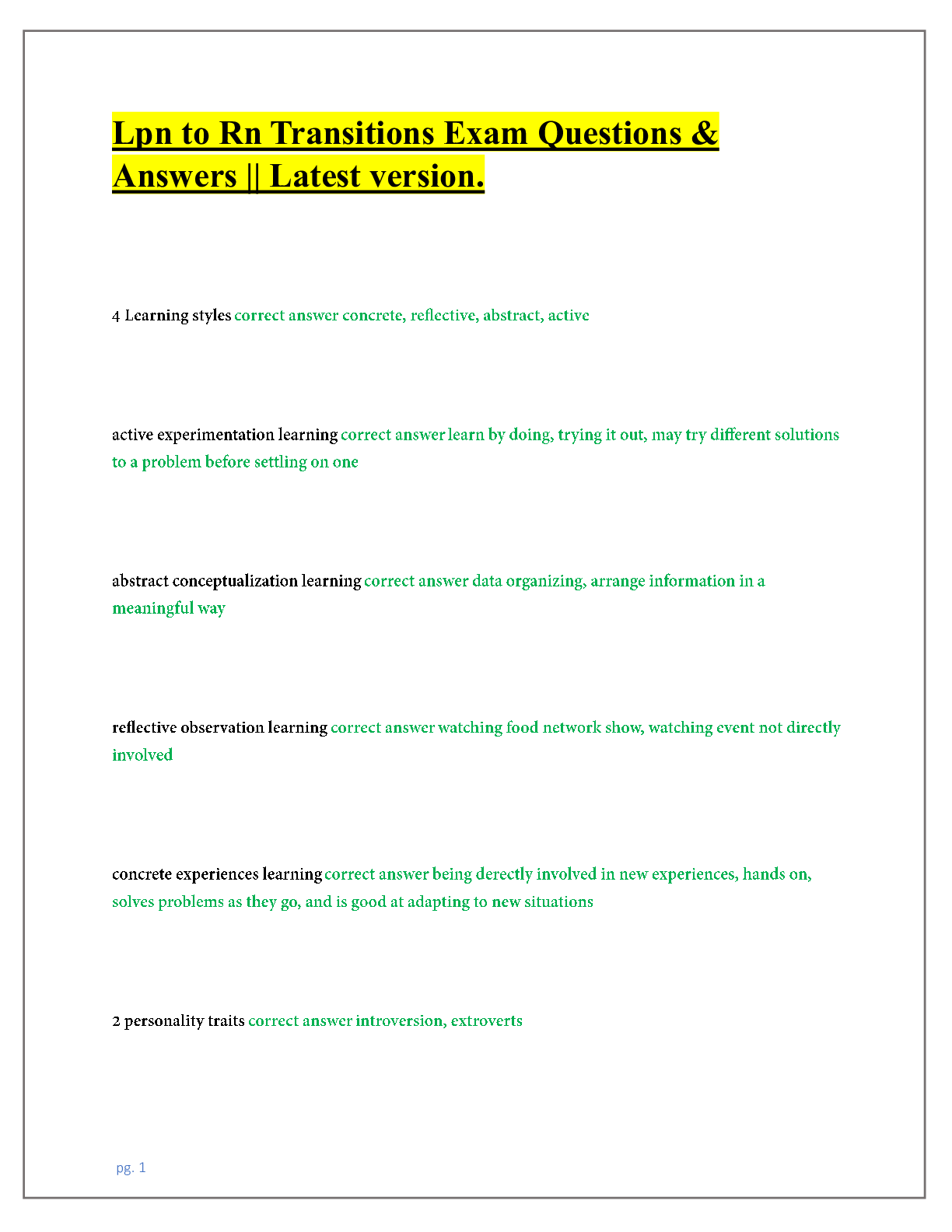

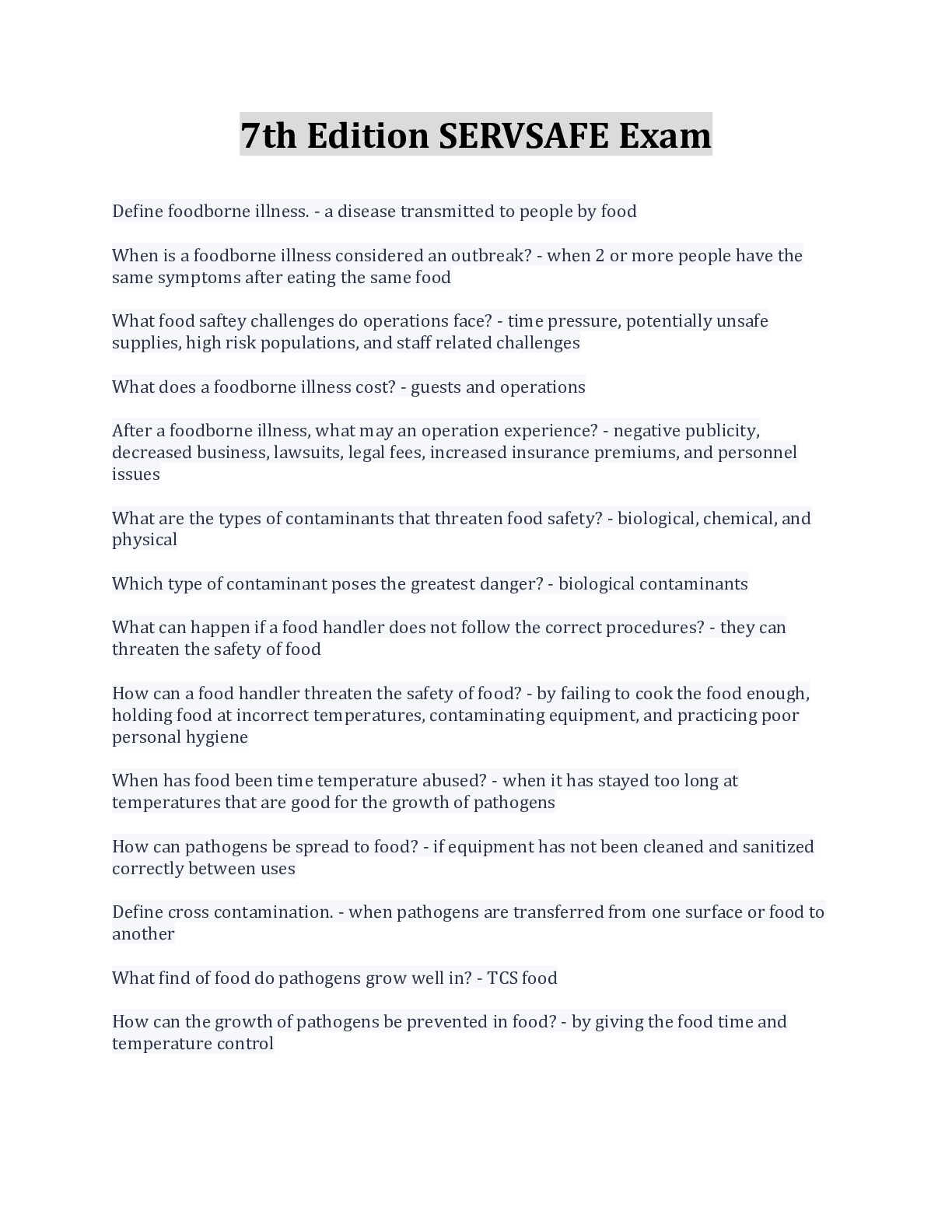


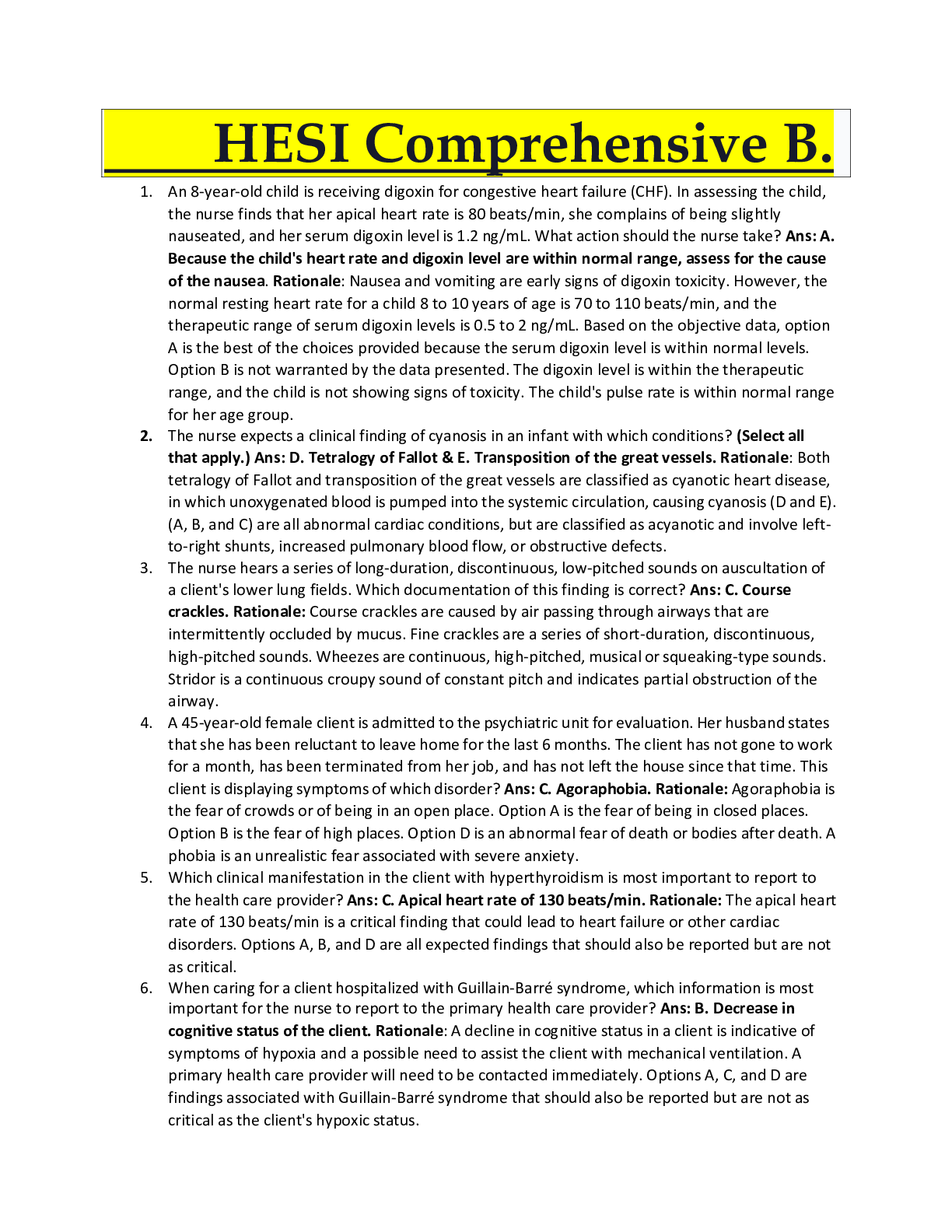
.png)
